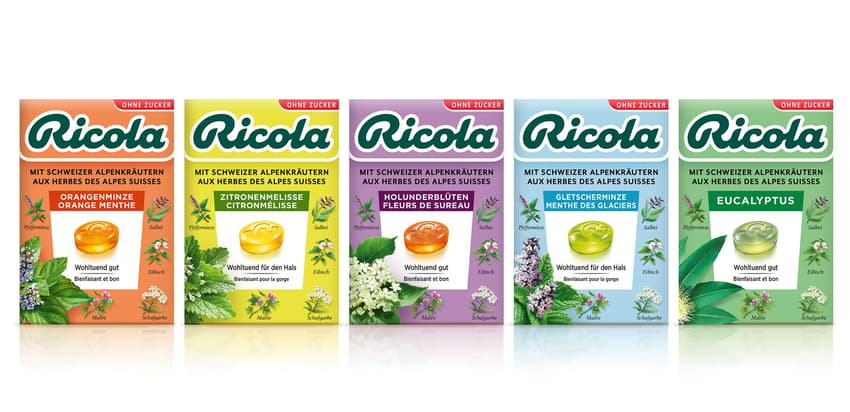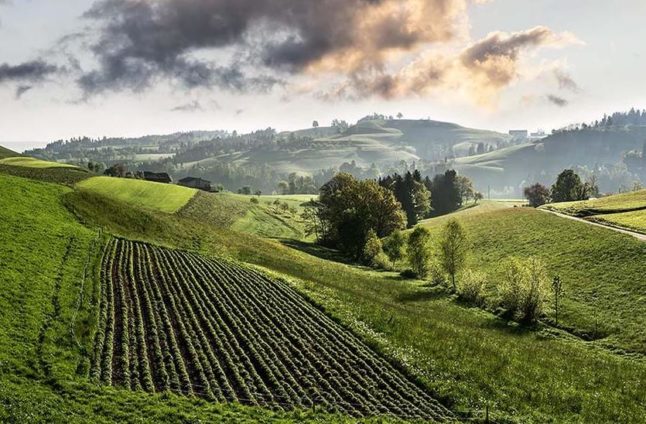Why the Swiss love their iconic Alpine candy Ricola

Yes, there is chocolate and cheese, but they are not the only delicacies Switzerland is known for. There is also another iconic, mouth-watering (literally) treat that is known practically everywhere in the world.
Question: What is typically Swiss and small enough to fit into your pocket? Clue: No, it is not an army knife.
If you answered ‘Ricola’, you are correct.
Unlike in the case of cheese and chocolate, however, no Swiss cows had any role in producing this delicious candy; instead, it’s ‘Swissness’ comes from another source — a lush and green Alpine meadow.
No less than 13 herbs are used to make this throat-soothing candy, all of which originally came from the hills around the town of Laufen in Basel-Country, where the company was born.

This is where Ricola herbs come from. Photo: Ricola press photo
Just a tiny drop
It was a local baker and confectioner Emil Richterich, who coughed up the idea for a throat-soothing, herb-based candy in 1930.
However, researching and experimenting with the healing properties of herbs took a decade (even in those days, the Swiss did things slowly and methodically).
The breakthrough, according to the company site, came in 1940 with the invention of the blend of 13 herbs: lady's mantle, elder, marsh mallow, peppermint, thyme, sage, cowslip, horehound, burnet, speedwell, mallow and yarrow.
They may sound like a witches’ brew, but they are all known for their therapeutic effect.
To add sweet and / or sour flavour to the bitter mixture of herbs, honey, lemon, or cranberry extracts are used.
"Emil Richterich’s virtually unchanged recipe still serves as the basis for all Ricola herb drops today," the company says.
The name Ricola, by the way, is a combination of initial syllables of Richterich & Co Laufen — Richterich’s original eponymous company.
Raw material crisis
In the 1980s, there were no longer enough grasslands in the Laufen valley from which to pick the essential herbs to make the lozenges.
Eventually, the company started working with Swiss farmers, who cultivated the herbs on their land.
In 2014, the company used clay any soil sourced from the Laufen Valley to build the Ricola Herb Center, which now serves as the central facility for processing and storing the herbs used to make the candy.
Ricola conquers the world
The company’s first attempt to expand from Switzerland to the outside world came in 1962, and was almost a flop.
"Efforts to launch the product on the German market were almost derailed due to the opinion of a Stuttgart-based trading partner that Ricola’s packaging ‘looked like a seed bag’ and would be impossible to sell," according to the site.
However, 50,000 bags were ordered nevertheless — "out of pity" – and in its first year, Ricola sold one million of these ‘seed bags’ in Germany.
Gradually, the cough drop was exported to other countries as well, with its benefits being shouted from the hilltops:
For years, this has been, as the company says, “a call heard around the world.»
These are come other typically ‘Swiss’ foods you may want to try:
What is Aromat and why are the Swiss so obsessed with it?
How can we explain the Swiss obsession with the drink Rivella?
Comments
See Also
Question: What is typically Swiss and small enough to fit into your pocket? Clue: No, it is not an army knife.
If you answered ‘Ricola’, you are correct.
Unlike in the case of cheese and chocolate, however, no Swiss cows had any role in producing this delicious candy; instead, it’s ‘Swissness’ comes from another source — a lush and green Alpine meadow.
No less than 13 herbs are used to make this throat-soothing candy, all of which originally came from the hills around the town of Laufen in Basel-Country, where the company was born.

This is where Ricola herbs come from. Photo: Ricola press photo
Just a tiny drop
It was a local baker and confectioner Emil Richterich, who coughed up the idea for a throat-soothing, herb-based candy in 1930.
However, researching and experimenting with the healing properties of herbs took a decade (even in those days, the Swiss did things slowly and methodically).
The breakthrough, according to the company site, came in 1940 with the invention of the blend of 13 herbs: lady's mantle, elder, marsh mallow, peppermint, thyme, sage, cowslip, horehound, burnet, speedwell, mallow and yarrow.
They may sound like a witches’ brew, but they are all known for their therapeutic effect.
To add sweet and / or sour flavour to the bitter mixture of herbs, honey, lemon, or cranberry extracts are used.
"Emil Richterich’s virtually unchanged recipe still serves as the basis for all Ricola herb drops today," the company says.
The name Ricola, by the way, is a combination of initial syllables of Richterich & Co Laufen — Richterich’s original eponymous company.
Raw material crisis
In the 1980s, there were no longer enough grasslands in the Laufen valley from which to pick the essential herbs to make the lozenges.
Eventually, the company started working with Swiss farmers, who cultivated the herbs on their land.
In 2014, the company used clay any soil sourced from the Laufen Valley to build the Ricola Herb Center, which now serves as the central facility for processing and storing the herbs used to make the candy.
Ricola conquers the world
The company’s first attempt to expand from Switzerland to the outside world came in 1962, and was almost a flop.
"Efforts to launch the product on the German market were almost derailed due to the opinion of a Stuttgart-based trading partner that Ricola’s packaging ‘looked like a seed bag’ and would be impossible to sell," according to the site.
However, 50,000 bags were ordered nevertheless — "out of pity" – and in its first year, Ricola sold one million of these ‘seed bags’ in Germany.
Gradually, the cough drop was exported to other countries as well, with its benefits being shouted from the hilltops:
For years, this has been, as the company says, “a call heard around the world.»
These are come other typically ‘Swiss’ foods you may want to try:
What is Aromat and why are the Swiss so obsessed with it?
How can we explain the Swiss obsession with the drink Rivella?
Join the conversation in our comments section below. Share your own views and experience and if you have a question or suggestion for our journalists then email us at [email protected].
Please keep comments civil, constructive and on topic – and make sure to read our terms of use before getting involved.
Please log in here to leave a comment.